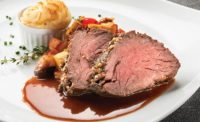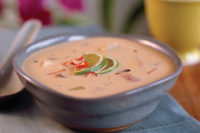Fermented Food Nation
Pickled and fermented foods are trending high, this time with a global flavor twist

SOURCE: iStock/peredniankina (www.istockphoto.com)

Asian cuisines, such as Korean, with multiple types of condiments, helped drive consumer interest in wide varieties of pickled and fermented ingredients.
SOURCE: Copyright: ksbank

Natto—fermented soy with its probiotics, vitamin K, and enzymes—exemplifies the healthful aspects of pickling and fermenting beyond simple preservation.
SOURCE: “Fermented Foods for Health”/ Deirdre Rawlings PhD (Fair Winds Press, June 2012)

Quark, a fresh, fermented cheese similar to ricotta, is the latest cultured dairy trend, with flavored quarks moving into Greek yogurt’s space in the dairy cases.
SOURCE: DSM Food Specialties N.V. (www.dsm.com)

Probiotic-rich cultured milk kefir has expanded from sweetened beverage to savory applications in sauces and dressings.
SOURCE: “Fermented Foods for Health”/ Deirdre Rawlings PhD (Fair Winds Press, June 2012)

From North African preserved lemons to South Asian achar to sweet and sour pickled vegetables, products prepared using fermentation and pickling have become culinarian staples.
SOURCE: iStock/vkuslandia (www.istockphoto.com)

Highly aromatic, very spicy, powerfully garlicky, and undeniably “cabbagey,” kimchi is becoming ubiquitous on menus and the refrigerated section in supermarkets.
SOURCE: Sura Korean Royal Cuisine Restaurant (www.surakoreancuisine.com)







When fermentation is brought up in a conversation these days rarely are beer, pickles, and cheese considered. Aromatic and intensely vinegary sauerkraut and kimchi often come to mind or perhaps zesty, sweet-and-sour kombucha tea. In the last few years, however, the health benefits of fermented foods stepped back into returned to prominence, as enlightened consumers enjoy both classic and non-traditional versions of what once were traditional forms of foods.
As the health benefits and fantastic flavors provided by the fermentation process continue to gain a foothold in the culinary world, processors are finding opportunities tailor-made for the packaged food industry. These products originated from the need for long, stable shelflives, after all.
Since ancient times, humans utilized the fermentation process. Humans have been fermenting or culturing foods as nourishing and flavorful ways to preserve food when refrigeration was not available. When beer, wine, and yogurt making is considered, food and drink fermentation has been happening longer than people have been writing words or cultivating soil. While direct archaeological evidence shows deliberate fermentation beginning approximately 10,000-12,000 years ago, circumstantial evidence indicates the practice could be two or more times longer.
Some of the earliest known writings have well-established recipes for beer and wine—the widespread popularity of which appears to be a given. The earliest evidence of an alcoholic beverage in the Far East—made from fruit, rice, and honey—dates from about 8,500 years ago, in China.
Jars with residues that suggest they were used for beer and wine making have been discovered everywhere from Georgia and Armenia, in the Caucasus, to Egypt and eastward across the Fertile Crescent into Iran. There is evidence people were fermenting foods and beverages almost as long in many places around the world. Pickling and fermentation was a primary food preservation method in a pre-industrial world.
There are many foods that are fermented in some way, yet the average consumer might not be aware of it. Wild yeasts and bacteria that are naturally occurring eat away at the mucilage layer that covers coffee beans after picking, naturally fermenting them slightly prior to the roasting stage. After cocoa beans are picked, the pulp surrounding them is deliberately allowed to ferment, thus darkening the beans.
These naturally occurring ferments aid in the development of the flavor, color, and texture of the finished product. Other everyday foods normally not considered when discussing fermentation include sourdough breads, vanilla beans, and many cured meats.
Beyond Beer and Dills
When today’s consumer enjoys the rich, deep flavors of pickles, sauerkraut, or kimchi—or perhaps vinegary white anchovies from Italy or Japanese pickled ginger—the focus isn’t on the fact that these items are prepared using one of the oldest processes for preserving foods. In modern times, the fermentation and pickling processes are used more to develop flavor than anything else. Although considered part of the raw movement by many, interest recently has increased for this broader purpose. (See “Raw: Defining Clean Food Label Trends,” PF, May 2016.)
“There’s definitely been a strong increase in interest in pickled vegetables and fruits over the past few years,” says Ari Weinzweig, founder of Zingerman’s Deli and author of Zingerman’s Guide to Good Eating.
“Obviously, fermented foods of this sort are anything but new—cheese, sourdough breads, salami and cured hams, coffee, chocolate, vinegar and, of course, wine and beer are all always highly popular—but we’re now seeing strong interest in fermented vegetables and fruits, with the focus on such foods from all over the world.”
One of the most popular mail-order gourmet food outlets in the US, Zingerman’s has greatly expanded its offerings in the category. “We now have Tunisian preserved lemons from the Mahjoub family; smoked pickled okra from Rick Field at Rick’s Picks LLC; and a variety of exceptional sauerkrauts from David Klingenberger’s The Brinery. We also carry pickled raisins, baby Brussels sprouts pickles, pickled walnuts, and many others. Customers are attracted to these products because of the flavor and the fact that they’re healthful, as well as being exotic yet surprisingly accessible,” Weinzweig adds.
Ann and Daniel Trudel, of Ann’s Raspberry Farm and makers of the Brussels sprout pickles Zingerman’s carries, opt for a basic preparation using minimal ingredients to keep the sprouts crisp and bright. They harvest the sprouts at an early stage, when each head is young and tender. The sprouts are cleaned, quickly blanched, then covered in a mixture of vinegar, honey, garlic, and spices.
Products prepared using fermentation and pickling lately have become staples on many restaurant menus, too. Nationally, high-end restaurants are highlighting fermented products and the processes of pickling and fermenting, as well. In fact, one Chicago area restaurant, Big Jones’, highlights pickled items with a pickle-tasting service that includes pickled watermelon and housemade piccalilli, the English-style variation on chutney using chopped pickled vegetables, spices, and often mustard.
At Michael Jordan’s Steakhouse, a new addition to the menu includes sea scallops accompanied by pickled butternut squash. Pickled cuisine is even making it into the “hinterlands,” with James Beard award-winning chef Tory Miller adding a pickled pintxo—a style of tapas—to his new Spanish cuisine restaurant, Estrellon, in Madison, Wisc. The surge in focus on vegetables as center-of-plate ingredients, even among non-vegetarians, also has a hand in the current pickle popularity.
“There’s definitely been a strong increase in interest in pickled vegetables and fruits over the past few years,” — Ari WeinzweigMany trend-spotters who included pickling and fermenting among their top food trends noted that, in addition to flavor and variety as drivers, the seasonal continuity of bringing summer produce flavors into year-round dishes is a big motivator.
Urbanspoon, a restaurant review site that uses data from users, reviews, and comments by experts, noted earlier this year, “Pickled and fermented foods have become increasingly popular.” The site also reported sightings of pickled cauliflower, onions, eggplant, zucchini, and fennel bulbs.
Kraut Komeback
Kimchi and sauerkraut are perhaps among the most unusual items to capture consumer attention. Highly aromatic, very spicy, powerfully garlicky, and undeniably “cabbagey,” kimchi is becoming ubiquitous on restaurant menus, and fresh packaged kimchi products are multiplying on mainstream supermarket refrigerated shelves. But it also now is being used in prepared meals. Suji’s Korean Cuisine Inc. has incorporated kimchi into some of its ready-to-heat offerings to provide an authentic culinary experience.
Whether led to the limelight by the popularity of spicy kimchi or simply gaining recognition as a pickled cabbage original, flavored and classic sauerkraut products are growing popular without benefit of the exotic patina of a Southeast Asian cuisine tradition. Farmhouse Culture LLC is one of the leading producers of refrigerated sauerkraut. The company continues to redefine the “fresh fermented” space with its organic, fresh, organic kraut line.
Defining its products as “innovative, probiotic-rich ferments inspired by global flavors,” the company creates the line from “local, all-organic ingredients, [featuring] organic cabbage, grown year-round in California.” Its new, 28,950-sq-ft facility includes a “temperature-perfect” fermentation room.
True to the trend, this is not your tante’s kraut. Flavor combos, such as smoked jalapeño, classic caraway, garlic dill pickle, horseradish leek, and spicy wakame ginger kimchi, make a sharp distinction between the Old World and New when creating pickled cabbage products. The company promotes nontraditional uses of its krauts, as well, such as in sandwiches, wraps and quesadillas; with grains and legumes; tossed in salads or soup; or as a condiment to egg dishes.
Another point of difference is that Farmhouse Culture sauerkrauts are packaged in pouches that “allow the live ferments to breathe.” The products do preserve a strong, crunchy fresh texture and full flavor throughout their shelflife.
All Rise
There is a clear difference between fermentation and pickling, especially when it comes to vegetables, fruits, and proteins. Fermentation, although it can occur naturally, is also a processing method that involves the salting or brining of an item—usually with the addition of an enzyme or microbe culture. This can be the introduction of bacteria either via inoculation or through a natural process by exposure to ambient air.
The fermenting mixture then rests under conditions controlled for temperature, pH, and time. Not only are such proper environmental parameters important, the product must remain completely submerged. This allows for growth of the beneficial bacteria over any harmful or undesirable microbes.
During the fermentation process, the microbes convert starch and sugar into lactic and acetic acid. As the beneficial micro-organisms grow and thrive, they outcompete the bad ones that can cause decomposition or spoilage; off-flavors and textures; or those that might even harm humans.
Without extreme care in the process, fermentation easily can go awry. For example, Alaska has experienced a steady increase in cases of botulism since 1985 and has more cases of the disease than any other state in the US. It has been determined this was caused when Inuit practicing traditional fermentation of animal products, such as whole fish, fish heads, seal oil, sea birds, and other wildlife foods, began using plastic containers instead of the old-fashioned, grass-lined hole. The Clostridium botulinum bacteria thrive in the anaerobic conditions created by the air-tight enclosure in plastic. The same is true of in-home fermenting, if the product is not totally submerged in the liquid medium and the mixture allowed to vent harmful microbes.
In yeast breads, the fermentation process occurs when live yeast converts sugars into carbon dioxide and causes the bread dough to rise. This process, called proofing, is the final rise of shaped bread dough before baking. It refers to a specific rest period within the more generalized process known as fermentation. Fermentation rest periods are not always explicitly named and can appear in formulations as simply, “allow dough to rise.” Other terms include “bulk fermentation,” “first rise,” “second rise,” “final proof,” and “shaped proof.”
In a Pickle
The pickling process usually involves adding a brine of vinegar, salt, and sugar to a vegetable, then storing it under controlled conditions to preserve and flavor. There basically are two methods of pickling. The primary or fresh pickling method is when an acid, such as vinegar, is added to the vegetable.
A less common preparation uses salt to create fermented picklings. Each method offers enhanced flavor to the vegetable medium, as well as health benefits. The fresh pickles maintain some of the products’ nutrients, while the fermented pickles provide the benefits of probiotic growth.
There are short-cuts to pickling that can be used. One method involves pouring a heated combination of vinegars and other acids, salt, sugar, and flavorings over vegetables and then chilling quickly. The results, while immediate and very pleasing both in appearance and organoleptic qualities, are not in the realm of true pickling or fermentation. They lack the processes’ deep, intense, and varied flavors.
Many ethnic flavor and cooking techniques can be incorporated into pickling endeavors. Asian spices, such as ginger, soy, star anise, and lemongrass, add excellent flavor to all kinds of pickled veggies. Spanish, African, and European flavor profiles—think: the classic dill—also add great flavor to pickled products.
The process of fermentation is great for chefs, in that it enables them to add a new skill to their repertoire. Fermentation techniques are new paradigms for chefs, as they are the polar opposites of what they normally practice.
Chefs always have used acid as a flavor enhancer. This has made the sudden re-emergence of pickled and fermented foods a natural extension of culinary development in processing. Kimchi and sauerkraut have expanded to include multiple variations and flavors on the theme. Many culinologists are experimenting with beans, cauliflower, turnips, eggplant, cucumbers, onions, squash, and carrots, as well as a host of fruits and combinations of both.
Using chutneys and vinegary vegetables, or sharply-flavored, sweet pickled fruits to add intense flavor notes to sauces or stews has captured the interest of developers. For example, incorporating some minced, preserved lemon into a tagine-style stew provides an easy note of authenticity to a prepared meal.
The advantage to the research chef is that only small amounts are needed; plus, most pickled or fermented additions will maintain well throughout the preparation process, from cooking through packaging to reheating and serving.
Fermented Dairy
Commercial fermenting, such as making cheese flavors or enzyme-modified cheese, usually requires the addition of a bacteria culture to the initial dairy product. The beginning dairy product and the specific culture, combined with the conditions of storage, all contribute to the flavor profile of the final product.
There are two major bacteria types used in cultures, mesophilic, those that thrive and grow optimally at lower temperatures (approximately 70-80°F) and thermophilic, those that thrive and grow optimally at approximately 110°F and above. The experience, knowledge, and talent of the flavor chemist are crucial to affecting the desired outcome.
Knowing the correct combination of raw dairy material, starter culture, and growing conditions are very important. Another key point knows how to stress the starter bacteria.
Subjecting the starter bacteria to conditions that are stressful, such as non-optimal growing conditions, places the bacteria in a “protection phase.” This phase can produce alternate flavor profiles that would not normally occur during optimal growth conditions.
Quark is the latest fermentation revival in the dairy sphere. A fresh, fermented cheese, similar to ricotta or farmer’s cheese, flavored quarks are taking shelf space between yogurt and cottage cheese. Similarly, Icelandic Provisions Inc. recently launched traditional skyr in the US. Made with heirloom cultures from Iceland, skyr contains more protein and less sugar than the currently popular Greek yogurt products. In fact, the low-fat product has approximately four times the milk contained in a cup of yogurt, with protein ranging from 14-17g per 150g serving.
The association of fermented foods with health is based on probiotic benefits. Fermented or cultured foods, from sauerkraut and kimchi to tempeh and natto (fermented soy), to dairy products such as soft-ripened cheese, yogurt, and quark, all contain friendly bacteria proven to be extremely beneficial to healthy human digestion and immunity.
These products also impart important nutrients. Some fermented foods are outstanding sources of essential nutrients, such as vitamin K2, which helps prevent arterial plaque buildup and heart disease, as well as supports bone health. Fermented foods also provide B vitamins. With probiotics a burgeoning frontier for developers and manufacturers of foods and beverages, fermented foods provide an opportunity to incorporate probiotic-rich components into a product that step beyond the classic beverage sources.
Originally appeared in the September, 2016 issue of Prepared Foods as Fermentation Nation.
A Little Sugar
French chemist Louis Pasteur was the first known modern zymologist—student of the chemical science of fermentation—when, in 1856, he described the connection of yeast to fermentation. Pasteur originally defined fermentation as “respiration without air.” Pasteur, through careful research, discovered the mechanism behind how lactose (milk sugar) changes into lactic acid, causing milk to sour.
Of course, Persians for centuries had enjoyed such naturally carbonated, fermented milk or yogurt in the traditional beverage doogh.) More important than determining that microbes, or microscopic organisms, cause fermentation, Pasteur also concluded that specific kinds of microbes cause specific types of fermentation. In this manner, he concluded that living yeast cells were causing alcohol to form from sugar.
Looking for a reprint of this article?
From high-res PDFs to custom plaques, order your copy today!












